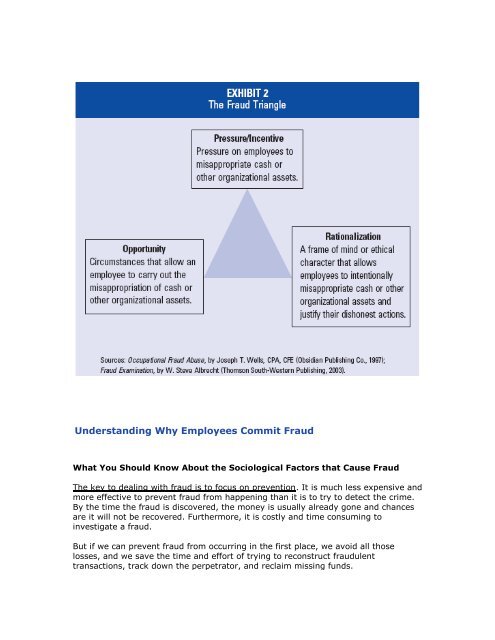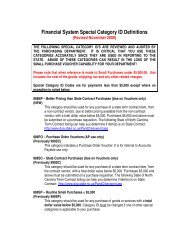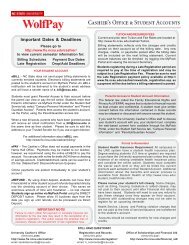Understanding Why Employees Commit Fraud - fis.ncsu.edu
Understanding Why Employees Commit Fraud - fis.ncsu.edu
Understanding Why Employees Commit Fraud - fis.ncsu.edu
Create successful ePaper yourself
Turn your PDF publications into a flip-book with our unique Google optimized e-Paper software.
<strong>Understanding</strong> <strong>Why</strong> <strong>Employees</strong> <strong>Commit</strong> <strong>Fraud</strong><br />
What You Should Know About the Sociological Factors that Cause <strong>Fraud</strong><br />
The key to dealing with fraud is to focus on prevention. It is much less expensive and<br />
more effective to prevent fraud from happening than it is to try to detect the crime.<br />
By the time the fraud is discovered, the money is usually already gone and chances<br />
are it will not be recovered. Furthermore, it is costly and time consuming to<br />
investigate a fraud.<br />
But if we can prevent fraud from occurring in the first place, we avoid all those<br />
losses, and we save the time and effort of trying to reconstruct fraudulent<br />
transactions, track down the perpetrator, and reclaim missing funds.
In order to prevent fraud, we must first understand why it occurs. What causes<br />
people to steal from their employers or to "cook" the books? Most people would say<br />
fraudsters are motivated by greed, but generally speaking, greed is not the primary<br />
motivator.<br />
To understand why employees, managers, and executives commit fraud, we must<br />
understand the fraud triangle.<br />
The <strong>Fraud</strong> Triangle<br />
Most people who commit fraud against their employers are not career criminals. The<br />
vast majority are trusted employees who have no criminal history and who do not<br />
consider themselves to be lawbreakers. So the question is, what factors cause these<br />
otherwise normal, law-abiding persons, to commit fraud?<br />
The best and most widely accepted model for explaining why "good people" commit<br />
fraud is the fraud triangle. This is a model developed by Dr. Donald Cressey, a<br />
criminologist whose research focused on embezzlers, people he called "trust<br />
violators."<br />
According to Cressey, there are three factors that must be present in order for an<br />
ordinary person to commit fraud. All three of these factors must be present at the<br />
same time in order for fraud to occur. The three factors are now referred to as:<br />
Pressure<br />
Pressure<br />
Opportunity<br />
Rationalization<br />
The first leg of the fraud triangle represents pressure, or what Cressey called a<br />
perceived non-sharable financial need. This is what motivates the crime in the first<br />
place. The fraudster has some financial problem that he is unable to solve through<br />
legitimate means, so he begins to consider committing an illegal act such as stealing<br />
cash or falsifying a financial statement as a way to solve his problem. The financial<br />
problem can be personal (too deep in personal debt) or professional (the person's<br />
job or business is in jeopardy). Examples of pressures that commonly lead to fraud<br />
include:<br />
Inability to pay one's bills<br />
Drug or gambling addiction<br />
Need to meet earnings to sustain investor confidence<br />
Need to meet productivity targets at work<br />
Desire for status symbols such as a bigger house, nicer car, etc.
Non-shareable problems and the importance of status<br />
Notice that Cressey did not say fraud is motivated by financial pressure, but instead<br />
by a non-shareable financial pressure. This is a very important distinction. Everybody<br />
has financial pressures, but not everybody commits fraud.<br />
What constitutes a non-shareable need is completely in the eye of the beholder. One<br />
person could lose his rent money gambling and will be motivated by this problem to<br />
write a company check to cover his rent. Another person might suffer the same loss<br />
and not feel compelled to commit an illegal act.<br />
Non-shareable problems all involve some sort of embarrassment, shame, or<br />
disgrace. More importantly, they all threaten the fraudster's status as a person who<br />
is trusted by others. In almost every fraud case, the fraudster's financial problem<br />
relates to status-seeking or status-maintaining. Consider the following examples:<br />
Opportunity<br />
A CEO develops a new business plan. Unfortunately, the plan fails miserably,<br />
and sales plummet. Having just suffered through two previous bad quarters,<br />
the CEO is afraid that this latest disaster will cost him his job. Unable to face<br />
the shareholders and the board of directors and tell them the bad news, the<br />
CEO persuades the CFO to help him create fictitious sales to mask the losses.<br />
The CEO is convinced that they can increase sales and correct the books next<br />
quarter.<br />
A high-ranking financial officer experiences heavy losses in her personal<br />
investments. She feels unable to admit to her personal financial failures<br />
because this would hurt her status as a highly trusted person who is in charge<br />
of her company's finances. Therefore, she tries to resolve her personal<br />
financial problem in secret by writing company checks to a shell company she<br />
controls.<br />
A business manager's division suffers losses due an economic downturn. This<br />
puts her division in jeopardy of missing its earnings targets. Even though the<br />
losses were due to forces beyond her control, the manager, who has a history<br />
of business successes, fears being labeled a failure if she misses her goals.<br />
She records fictitious sales in order to maintain the appearance of success.<br />
A bank teller desires prestige symbols such as a nicer car, better clothes,<br />
jewelry, etc., but she cannot afford them on her salary. Because she cannot<br />
legitimately obtain these items, and because she is unwilling to "settle" for<br />
less expensive counterparts, she begins stealing from her cash drawer to<br />
purchase these status symbols.<br />
The second leg of the fraud triangle is opportunity, sometimes referred to as<br />
perceived opportunity, which defines the method by which the crime can be<br />
committed. The person must see some way she can use (abuse) her position of trust<br />
to solve her financial problem with a low perceived risk of getting caught.<br />
It is also critical that the fraudster be able to solve her problem in secret. Remember<br />
that fraudsters are motivated by concerns over status. If a perpetrator is caught
embezzling or falsifying financial information, this will hurt her status at least as<br />
much as the underlying problem she was trying to conceal. So the fraudster not only<br />
has to be able to steal funds, she has to be able to do it in such a way that she will<br />
likely not be caught and the crime itself will not be detected.<br />
For example, if an employee has access to blank checks she may see an opportunity<br />
to forge a company check payable to herself. But that check might well be spotted<br />
during the reconciliation of the bank statement and she would be caught. In this<br />
case, even though there is an opportunity to steal the funds, there is no opportunity<br />
to steal them in secret. But suppose the same employee also reconciles the<br />
company's bank statement. Now, she can write a check payable to herself and then<br />
when the bank statement arrives she can destroy the fraudulent check and force the<br />
balance on the reconciliation. Now the person has a perceived opportunity to commit<br />
fraud.<br />
Rationalization<br />
The third leg of the fraud triangle is rationalization. As we stated already, the vast<br />
majority of fraudsters are first-time offenders with no criminal past. They do not<br />
view themselves as criminals. They see themselves as ordinary, honest people who<br />
are caught in a bad set of circumstances.<br />
Because the fraudster does not see himself as a criminal, he must justify the crime<br />
to himself in a way that makes it an acceptable or justifiable act. This is known as<br />
rationalization. Common rationalizations include the following:<br />
I was only borrowing the money<br />
I was entitled to the money<br />
I had to steal to provide for my family<br />
I was underpaid/my employer had cheated me<br />
My employer is dishonest to others and deserved to be fleeced<br />
While the perpetrator must rationalize the crime to himself before he commits the<br />
crime, after the act has taken place the rationalization will often be abandoned.<br />
When Does the <strong>Fraud</strong> Triangle Not Apply?<br />
The fraud triangle applies to most embezzlers and occupational fraudsters, but it<br />
does not apply to the "predatory employee"—the person who takes a job with the<br />
intent of stealing from his employer.<br />
Also, as we stated earlier, while a rationalization is necessary for most people to<br />
begin committing fraud, the rationalization will often be abandoned after the initial<br />
act has taken place. Most frauds are not one-time events. They usually start as small<br />
thefts or misstatements and they gradually increase in size and frequency. As the<br />
perpetrator repeats the act, it becomes easier to justify until no justification is<br />
needed at all.
What Does the <strong>Fraud</strong> Triangle Tell Us?<br />
Perhaps the most important lesson to be learned from the fraud triangle is that<br />
normally all three factors must be present for fraud to occur. If any one of the three<br />
elements is missing, fraud will normally not occur.<br />
Cressey's model also tells us that concerns over status, not greed, is the primary<br />
motivator for occupational fraud.<br />
<strong>Why</strong> Sanctions Don't Deter <strong>Fraud</strong><br />
We can also d<strong>edu</strong>ce from the fraud triangle that simply punishing people who are<br />
caught committing fraud is not an effective way to deter fraud. There are several<br />
reasons why this is so:<br />
<strong>Fraud</strong>sters only commit their crimes when there is a perceived opportunity to<br />
solve their problems in secret. In other words, fraudsters do not anticipate<br />
getting caught. The threat of sanctions does not carry significant weight with<br />
a fraudster because he never expects to face them.<br />
<strong>Fraud</strong>sters rationalize their conduct so that it seems legal or justified. Thus,<br />
they do not see their actions as something that is or should be sanctioned.<br />
Because fraudsters are primarily motivated by status, the greatest threat<br />
they face is that their crime will be detected. Detection will result in loss of<br />
status. Any sanctions that follow are only a secondary consideration.<br />
Building an Effective Deterrence Program<br />
<strong>Fraud</strong> deterrence will be discussed in more detail later in this program, but CPAs<br />
should understand that the fraud triangle provides an outline for deterring fraud in<br />
any company. An effective deterrence program will directly target the three elements<br />
of the fraud triangle. Organizations should seek to:<br />
1. R<strong>edu</strong>ce pressures on employee that might push them into committing<br />
fraud.<br />
2. R<strong>edu</strong>ce perceived opportunities to commit fraud.<br />
3. Dispel rationalizations for engaging in fraudulent conduct.





